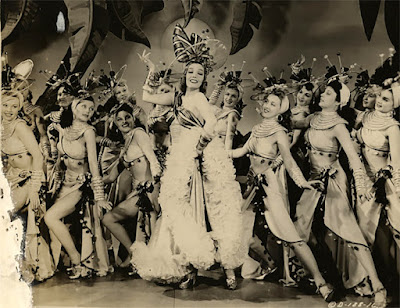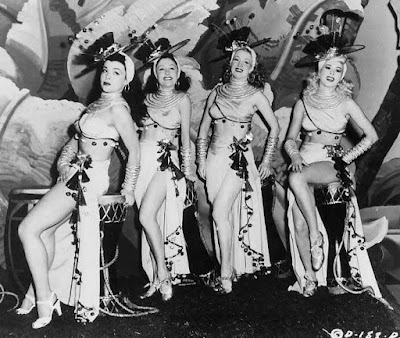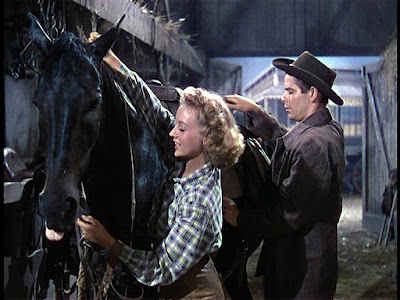Founded in 1924, Columbia was considered a second-rate production company in its first decade. 1935, the studio's It Happened One Night swept the major Academy Awards, elevating the film factory to second-tier status. Travilla's first film for them was Two Yanks in Trinidad starring Brian Donlevy, Pat O'Brien as wartime buddies uncovering and overcoming Nazi espionage plans with a nightclub singer played by Janet Blair.
According to the Hollywood Reporter's front-page blurb, his contributions to earned him a two-picture deal with the studio in July. His first two assignments were Something to Shout About, a Gregory Ratoff musical starring Janet Blair, and The Desperadoes, a Glenn Ford and Claire Trevor western. Travilla cannot be confirmed as the designer for Something, but around the same period, Travilla worked on Redheaded Woman From Manhattan, one of Mexican Spitfire Lupe Velez's last pictures.
Released the same month was Columbia's first Technicolor film, Desperado, starring Claire Trevor as a gambling hall owner in love with the town's sheriff played by Randolph Scott. Her former lover and current outlaw blows into town and cause trouble. Evelyn Keyes played the wholesome ingenue who catches Ford's eye.
The costuming for Trevor's production brought praise from the Hollywood Reporter, who found the actress "wore the eye-filling Travilla wardrobe to fine effect," a critique from one eagle-eyed filmgoer, who wrote a letter discovered pasted in one of his scrapbooks from the mid-40s.
Dated Friday 13th, Mrs. Leonard Heffern of 566 North Kingsley Drive, Los Angeles, wrote, "The costumes were lovely, but they were in style in the nineties and not the sixties. I never studied dress design, but I kept my eyes open and had a vague idea about what they wore. You make styles your life work. I can't see why you don't take the trouble to research the subject. That one thing spoiled the show for me...Please don't make this mistake again."
In a lengthy reply dated August 26, a "pleasantly surprised" Travilla answered his critic.
"Unfortunately, I am compelled to agree with everything you wrote regarding Miss Trevor's wardrobe being of the 'nineties rather than the 'sixties. I hope you won't think me facetious, Mrs. Heffern, when I tell you I knew it before you did. When I was given the script to read, the story was set in the '90s, and I designed clothes absolutely proper for the period. After the clothes were in work in our shop here, changes the story were made, and the dates moved thirty years for some reason or reasons known only to those who make movies. I protested that the things to be worn by Miss Trevor were ALL WRONG but was over-ruled because they were more flattering to her than dresses of the CORRECT period would have been."
"That, or similar situations, explains why disconcerting people like yourself frequently detect anachronisms in motion pictures. All designers have reference works and pride themselves in their knowledge of little details. For instance, the year the first "leg o' mutton" sleeve made its appearance. We KNOW but frequently aren't permitted to make use of what we know. A producer looks at designs and says, "I don't like that – inject a little sex into it," so I more or less subtlety inject into a hoop skirt or bustle. Or a star says: "Oh, that's impossible for me – I wouldn't look well in that," and if she is a big enough star, we change the sketch again to accentuate her good points and hide her bad ones. Perhaps inject some feature in the dress which was never used until 20 years after she died – in the picture."
So in the future, Mrs. Heffern, when you and your mother notice such things in a picture, DON'T blame the poor designer. I do appreciate your writing to me. If more moviegoers took the trouble to let producers know about such things, maybe the designer's lot would...
(Unfortunately, the lower portion of the letter is missing. However, it did elicit a reply dated the same day from Mrs. Leonard, whom he'd won over with his charm and manners.)
"I was pleased and flattered to hear from you. I guess we all have our troubles. I forgot to tell you that I thought your costumes were beautiful. You certainly know what looks well on blondes. I started studying graphology a few weeks ago, and here is what I found out about your writing according to your signature. You have an atheistic nature: You like beautiful surroundings. Your tastes (are) refined and artistic. You are intuitive, witty, and good-humored. You are the inspirational type of artist. Your personality is an asset to you."
Keyes was garbed in various denims, flannel or cottons, with several dresses in various patterns, necklines, and sleeve treatments.

.jpg)











































No comments:
Post a Comment